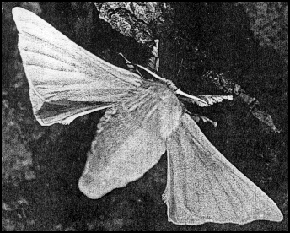
Oriental silkworm moth, Bombyx mori

Oriental silkworm moth, Bombyx mori
Pheromones are widely used as a means of conspecific chemical communication throughout the animal kingdom. In 1959 Butenandt succeeded to identify the chemical structure of sex attractant emitted by female oriental silkworm moth, Bombyx mori, and named the substance bombycol (Evans, 1984). Butenandt, together with Karlson, introduced the term "pheromone" for these substances (Richards & Davies,1977). Moths are known to have an acute olfactory sense and various aspects of chemistry and its related behavior of moth attractants have been studied. From the perspective of pest control, sex pheromone trap is an important alternative for invasive pesticides.
Tree of Life: Bombycoidea
Pheromone is a volatile molecule which, when released into the air, forms an elongated plume called an active space (Wilson, 1970). The shape and the size of an active space varies depending on the weight of the molecule and the wind velocity (Robinson,1994). When a male moth detects pheromone molecules emitted by a female moth, it starts searching for a point source. Interestingly, the animal uses the wind direction to orient himself (anemotaxis) (Kennedy, 1983). Shwinck demonstrated, using flightless mutants, that the animal moves upwind irrespective of the position or presence of the female (Evans, 1984). The observation of the pheromone searching behavior of flying insects became available with the technique using a wind tunnel introduced by Kennedy and Marsh (Evans, 1984). The insect orients itself anemotactically and shows sinusoidal zigzag movement across the longitudinal axis of the odor plume (Farkas and Shorey, 1972). Kennedy and Marsh (1974) presented that the optomotor reactions to the moving ground pattern is necessary to guide the anemotactic orientation. Moreover, when the odor stimulus is removed, the moth's anemotactic angle is lost and the animal shows a left-right zigzag flight with larger amplitude until its axis is 90 degree to the wind direction (casting) (Kennedy and Marsh, 1974). The anemotaxis is so essential for the mate location that the male, upon loss of contact with the odor plume, flies back downwind to reenter the active space (Murliss and Bettany, 1977). The counter turning the animal makes during the course of mate searching behavior, whether zigzag or casting, is considered to be self-steering and its function is to maintain the contact with the odor molecules (Kennedy, 1983).

The sex pheromone receptors of the male silkworm moth. (a) Moth; (b), branches
of antenna; (c) sensory hairs, each containing two sensory neurons, one
sensitive to bombykol, the other to bombykal; (d) longitudinal section of
a hair, showing dendrites and pores in the cuticle; (e) cuticular pore,
with tubules extending into the lumen of the hair to adjoin the dendrites.
D, dendrite; H. lumen of antennal branch with inserted electrode; P. pore;
PT, pore tubule; RC, receptor cell (sensory neuron); RE, recording electrode
inserted over tip of sensory hair; SH, sensory hair. (Adapted from Evans
HE (1984) Insect Biology. Addison-Wesley Publishing Company, Inc.)
The neuronal circuitry that mediates the moth pheromone searching behavior
has not yet been determined. The first step in the process is a chemoreception.
Therefore, the moth olfactory mechanism is briefly described here.
Sencilla is a hair-like sense organ of insects that consists of sensory neuron and cuticular structures (Evans, 1984). The sencilla which is specialized for the sex pheromone reside on the antenna. In order to reach the sensory neuron, the pheromone molecules have to cross the hair wall through the pore tubules (Kaissling and Williams, 1990). Upon contact with a dendrite, pheromone molecules elicit an electric response in the sensory neuron. It has been proposed that the interaction between pheromone molecules and the surface protein on the dendrite modifies firing of sensory neuron's action potential (Kaissling, 1971). Moth sex pheromone does not consist of single molecule but is a blend of different compounds. The ratio of each component in the pheromone differs from species to species. Each sensory neuron is tuned to specific components (Lucas and Renou, 1989). Therefore, the labelled line coding seems to be involved. Several studies have been carried out to identify different types of sencillum whose threshold and response to particular pheromone components differ from each other. For example, Grant and O'Connell (1985) have found two types of sencillum on the antenna of Trichoplusia ni. Each sencilla has two sensory neurons whose action potential amplitude and the rate of spontaneous firing are different. These neurons are sensitive to different components of the pheromone and are excited by low levels of different components. Two types of sencilla have been revealed to be distinguishable both electrophysiologically and morphologically.
Early classics:
Kennedy JS (1974) Pheromone-regulated
anemotaxis in flying moths. Science 184: 999-1001.
Farkas SR, Shorey HH, Gaston LK (1974) Sex pheromones of Lepidoptera. Annals of the Entomological Society of America 67: 633-638.
Marsh D, Kennedy JS, Ludlow AR (1978) An analysis of anemotactic zigzagging flight in male moths stimulated by pheromone. Physiol Ent 3: 221-240.
Reviews:
Kennedy JS (1983) Zigzagging and casting as a programmed response to wind-borne
odour : a review. Physiol Ent 8: 109-120.
Shorey HH (1976) Animal Communication by Pheromones. Academic Press.
Some Recent Advances:
Renou M (1991) Sex pheromone reception in the moth, Mamestra thalassina.
Characterization and distribution of two types of olfactory hairs. J
Insect Physiol Vol 37 No 8: pp 617-626.
Renou M and Lucas P (1994) Sex pheromone reception in Mamestra brassicae L. (Lepidoptera): Responses of olfactory receptor neurons to minor components of the pheromone blend. J Insect Physiol Vol 40 No 1: pp 75-85.
Mankin RW and Hagstrum DW (1995) Three-dimensional orientation of male Cadra cautella (Lepidoptera: Pyralidae) flying to calling females in a windless environment. Environmental Entomology v 24 Dec pp 1616-26.
